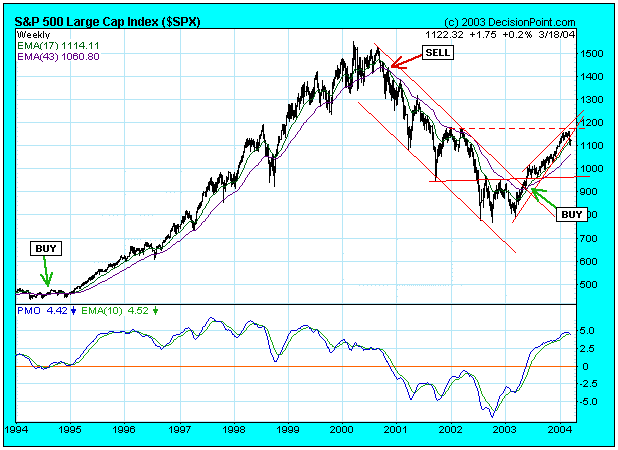
The trend and condition of the market should dictate the kind of actions we will take, so these are the first things we should evaluate during the process of making investment/trading decisions. This process is necessary for all time frames, but for this article I will focus on the longer-term.
TREND: On a weekly-based chart we can evaluate the longer-term trend of the market using trend lines and moving averages. We can see that the long-term trend line drawn from the 2000 price top has been violated to the up side, and a new up trend is in the making. For a more objective definition of the trend I use the 17-week (fast) and 43-week (slow) exponential moving averages (EMAs). When the fast EMA crosses the slow EMA, it generates a buy or sell signal depending on the direction of the crossover. Currently, the 17-EMA is above the 43-EMA, so a buy signal is in effect and the trend is officially up. The 10-year period on the chart shows how effective the 17/43-EMA relationship is for catching long-term trends.
CONDITION: Next we want to determine the condition of the market within the trend. Specifically, is it overbought or oversold? Again we can use the relationship of the 17/43-EMAs, only this time we look to see how far they are apart. Comparing other periods where corrective action has taken place, we can see that the 17-EMA is well above the 43-EMA and showing the market to be very overbought. Also, the weekly PMO (Price Momentum Oscillator) has had a very long run from its October 2002 low, and it too is very overbought.
Finally, we can see that the market is already reacting to the overbought condition. The rising trend line from the March 2003 price low has been violated, and the PMO has topped and generated a crossover sell signal. These events imply that the current correction will continue for several more weeks; however, in the context of a long-term rising trend it is not likely that we have seen the final top for the bull market, but, of course, that remains to be seen.
ACTIONS: In a rising trend we look for opportunities to buy, but during a correction it is not likely that we will find very many. In fact, with the correction in progress, the more immediate priority will be to appropriately adjust stops on long positions and raise some cash for the time when the correction is finally over and new buying opportunities begin to pop up all over the place.






